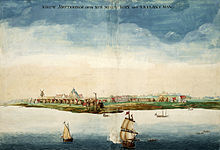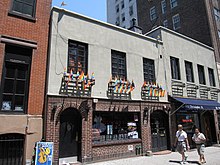The region was inhabited by the Lenape Native Americans at the time of its European discovery in 1524 by Giovanni da Verrazzano, a Florentine explorer in the service of the French crown, who named it "Nouvelle Angoulême" (New Angoulême). European settlement began with the founding of a Dutch fur trading settlement, later called "Nieuw Amsterdam" (New Amsterdam), on the southern tip of Manhattan in 1614. Dutch colonial Director-General Peter Minuit purchased the island of Manhattan from the Lenape in 1626 for a value of 60 guilders (about $1000 in 2006); a disproved legend says that Manhattan was purchased for $24 worth of glass beads.
In 1664, the city was surrendered to the English and renamed "New York" after the English Duke of York and Albany. At the end of the Second Anglo-Dutch War the Dutch gained control of Run (then a much more valuable asset) in exchange for the English controlling New Amsterdam (New York) in North America. Several intertribal wars among the Native Americans and some epidemics brought on by the arrival of the Europeans caused sizable population losses for the Lenape between the years 1660 and 1670. By 1700, the Lenape population had diminished to 200. In 1702, the city lost 10% of its population to yellow fever. New York underwent no fewer than seven important yellow fever epidemics from 1702 to 1800.
New York grew in importance as a trading port while under British rule. The city hosted the influential John Peter Zenger trial in 1735, helping to establish the freedom of the press in North America. In 1754, Columbia University was founded under charter by George II of Great Britain as King's College in Lower Manhattan. The Stamp Act Congress met in New York in October of 1765 as the Sons of Liberty organized in the city, skirmishing over the next ten years with British troops stationed there.
During the American Revolution, the largest battle of the war, the Battle of Long Island, was fought in August 1776 entirely within the modern day borough of Brooklyn. After the battle, in which the Americans were routed, and subsequent smaller engagements following in its wake, the city became the British military and political base of operations in North America. The city was a haven for Loyalist refugees, until the war ended in 1783. The only attempt at a peaceful solution to the war took place at the Conference House on Staten Island between American delegates including Benjamin Franklin, and British general Lord Howe on September 11, 1776. Shortly after the British occupation began the Great Fire of New York occcured, a large conflagration which destroyed about a quarter of the buildings in the city including Trinity Church.
The assembly of the Congress of the Confederation made New York the national capital in 1785, shortly after the war. New York was the last capital of the U.S. under the Articles of Confederation and the first capital under the Constitution of the United States. In 1789 the first President of the United States, George Washington, was inaugurated; the first United States Congress and the Supreme Court of the United States each assembled for the first time, and the United States Bill of Rights was drafted, all at Federal Hall on Wall Street. By 1790, New York had surpassed Philadelphia as the largest city in the United States.
In the 19th century, the city was transformed by immigration and development. A visionary development proposal, the Commissioners' Plan of 1811, expanded the city street grid to encompass all of Manhattan, and the 1819 opening of the Erie Canal connected the Atlantic port to the vast agricultural markets of the North American interior. Local politics fell under the domination of Tammany Hall, a political machinesupported by Irish immigrants. Several prominent American literary figures lived in New York during the 1830s and 1840s, including William Cullen Bryant, Washington Irving, Herman Melville, Rufus Wilmot Griswold, John Keese, Nathaniel Parker Willis, and Edgar Allan Poe. Public-minded members of the old merchant aristocracy lobbied for the establishment of Central Park, which became the first landscaped park in an American city in 1857. A significant free-black population also existed in Manhattan and Brooklyn. Slaves had been held in New York through 1827, but during the 1830s New York became a center of interracial abolitionist activism in the North. New York's black population was over 16,000 in 1840. The Great Irish Famine brought a large influx of Irish immigrants, and by 1860, one in four New Yorkers – over 200,000 – had been born in Ireland.
Anger at military conscription during the American Civil War (1861–1865) led to the Draft Riots of 1863, one of the worst incidents of civil unrest in American history.
In 1898, the modern City of New York was formed with the consolidation of Brooklyn (until then a separate city), the County of New York (which then included parts of the Bronx), the County of Richmond, and the western portion of the County of Queens. The opening of the subway in 1904 helped bind the new city together. Throughout the first half of the 20th century, the city became a world center for industry, commerce, and communication. However, this development did not come without a price. In 1904, the steamship General Slocum caught fire in the East River, killing 1,021 people on board.
In 1911, the Triangle Shirtwaist Factory fire, the city's worst industrial disaster until the 9/11 World Trade Center disaster, took the lives of 146 garment workers and spurred the growth of the International Ladies' Garment Workers' Union and major improvements in factory safety standards.
New York's nonwhite population was 36,620 in 1890. In the 1920s, New York City was a prime destination for African Americans during the Great Migration from the American South. By 1916, New York City was home to the largest urban African diaspora in North America. The Harlem Renaissance flourished during the era of Prohibition, coincident with a larger economic boom that saw the skyline develop with the construction of competing skyscrapers.
New York became the most populous urbanized area in the world in early 1920s, overtaking London, and the metropolitan area surpassed the 10 million mark in early 1930s, becoming the first megacity in human history. The difficult years of the Great Depression saw the election of reformer Fiorello LaGuardia as mayor and the fall ofTammany Hall after eighty years of political dominance.
Returning World War II veterans created a postwar economic boom and the development of large housing tracts in eastern Queens. New York emerged from the war unscathed as the leading city of the world, with Wall Street leading America's place as the world's dominant economic power. The United Nations Headquarters(completed in 1950) emphasized New York's political influence, and the rise of abstract expressionism in the city precipitated New York's displacement of Paris as the center of the art world.
In the 1960s, New York City began to suffer from economic problems and rising crime rates. While a resurgence in the financial industry greatly improved the city's economic health in the 1980s, New York's crime rate continued a steep uphill climb through the decade and into the beginning of the 1990s. By the 1990s, crime rates started to drop dramatically due to increased police presence and gentrification, and many American transplants and waves of new immigrants arrived from Asia and Latin America. Important new sectors, such as Silicon Alley, emerged in the city's economy and New York's population reached an all-time high in the 2000 census.
The city was one of the sites of the September 11, 2001 attacks, when nearly 3,000 people died in the destruction of the World Trade Center. A new 1 World Trade Center, a World Trade Center Memorial and three other office towers, are being built on the site and are scheduled for completion by 2014. The new World Trade Center site skyscrapers, memorial, and a new transportation hub that are under construction at the site will bring about a more modern Lower Manhattan and restore the skyline of New York City.




No comments:
Post a Comment